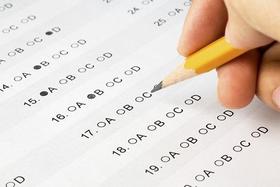- Chesapeake College is a comprehensive public two-year regional community college serving the educational needs of the residents of Caroline, Dorchester, Kent, Queen Anne's and Talbot counties on Maryland's Upper Eastern Shore. The College's mission is to provide a learner-centered environment that provides affordable, quality, educational experiences and support services, a focus on student achievement, choice in instructional delivery, and innovative use of instructional technology. This environment maximizes students' potential for intellectual and personal growth.
School Highlights
Chesapeake College serves 2,431 students (20% of students are full-time).
The college's student-teacher ratio of 8:1 is lower than the state community college average of 12:1.
Minority enrollment is 31% of the student body (majority Black), which is less than the state average of 63%.
Quick Facts (2025-26)
- Enrollment: 2,431 students
- In-state tuition: $5,120
- Out-state tuition: $6,968
- Student-teacher ratio: 8:1
- Minority enrollment: 31%
- Source: Integrated Postsecondary Education Data System (IPEDS)
School Overview
The teacher population of 290 teachers has stayed relatively flat over five years.
Chesapeake College
(MD) Community College Avg.
Carnegie Classification
Associate's Colleges: Mixed Transfer/Career & Technical-High Traditional
Associate's Colleges: High Transfer-Mixed Traditional/Nontraditional
Institution Level
At least 2 but less than 4 years
At least 2 but less than 4 years
Institution Control
Public
Public
Total Faculty
290 staff
446 staff
Student Body
The student population of Chesapeake College has grown by 11% over five years.
The student-teacher ratio of 8:1 has increased from 7:1 over five years.
The Chesapeake College diversity score of 0.50 is less than the state average of 0.75. The school's diversity has stayed relatively flat over five years.
Total Enrollment
2,431 students
5,610 students
Student-Teacher Ratio
8:1
12:1
# Full-Time Students
483 students
1,128 students
# Part-Time Students
1,948 students
4,482 students
# Enrollment Undergraduate
243 students
319 students
# Full-Time Undergraduate Students
483 students
1,128 students
# Part-Time Undergraduate Students
1,948 students
4,482 students
% American Indian/Alaskan
n/a
n/a
% Asian
2%
7%
% Hispanic
8%
13%
% Black
13%
30%
% White
69%
37%
% Hawaiian
n/a
n/a
% Two or more races
4%
5%
% Non Resident races
1%
5%
% Unknown races
3%
3%
Diversity Score
0.50
0.75
College Completion Rate (Students who graduate in less than 4 years)
28%
28%
Average Graduate Earnings (10 Years)
$30,800
$36,700
Tuition and Acceptance Rate
The public in-state tuition of $5,120 is less than the state average of $5,633. The in-state tuition has declined by 7% over four years.
The public out-state tuition of $6,968 is less than the state average of $7,892. The out-state tuition has declined by 5% over four years.
In-State Tuition Fees
$5,120
$5,633
Out-State Tuition Fees
$6,968
$7,892
% Students Receiving Some Financial Aid
72%
72%
Median Debt for Graduates
n/a
$10,000
Median Debt for Dropouts
n/a
$5,500
Acceptance Rate
n/a
100%
Source: 2024 (or latest year available) Integrated Postsecondary Education Data System (IPEDS)
School Notes
- Chesapeake College, founded in 1965 offers two-year program of study in liberal arts and sciences and career programs. Degrees granted includes Associate of Arts, Associate of Arts in Teaching, Associate of Science, Associate of Applied Science, Certificate and Letter of Recognition. The College offers a large selection of credit and continuing education offerings designed to help students prepare for transfer to upper level institutions, for immediate entry into a career, or for enhancing work-related skills. Beyond the curricula, the College offers many opportunities for further academic, social, personal, cultural, and athletic development through a rich variety of extracurricular and co-curricular activities. Our main campus is located at Wye Mills covering 170 acres. Chesapeake College Cambridge Center is located at 416-418 Race Street in Cambridge. Chesapeake College Center for Allied Health, Memorial Hospital located at 219 South Washington Street, Easton, Maryland. Off-campus teaching locations are at various sites throughout Caroline, Dorchester, Kent, Queen Anne's,and Talbot counties. To enhance student learning and to promote teaching excellence, the College commits to providing a supportive learning environment characterized by a dedicated, caring and highly qualified faculty and staff. The College offers all employees professional development opportunities that are aligned with goals outlined in its Strategic Plan. Through these commitments, the College nurtures a community of lifelong learners among faculty, staff and students.
Frequently Asked Questions
How much does Chesapeake College cost?
Chesapeake College's tuition is approximately $5,120 for In-State students and $6,968 for Out-State students.
Recent Articles

How to Transfer from Community College to a Four-Year University in 2025
A step-by-step guide for community college students transferring to a four-year university in 2025 — updated strategies, data and expert insights.

Scholarships for Community College Students 2025
Explore updated scholarship programs, tuition data, and expert strategies for community college students in 2025.

The Rise of Technical and Vocational Training in 2025
Explore the 2025 surge in technical and vocational training—enrollment, policy, costs, and why this path is gaining ground for students and parents.









